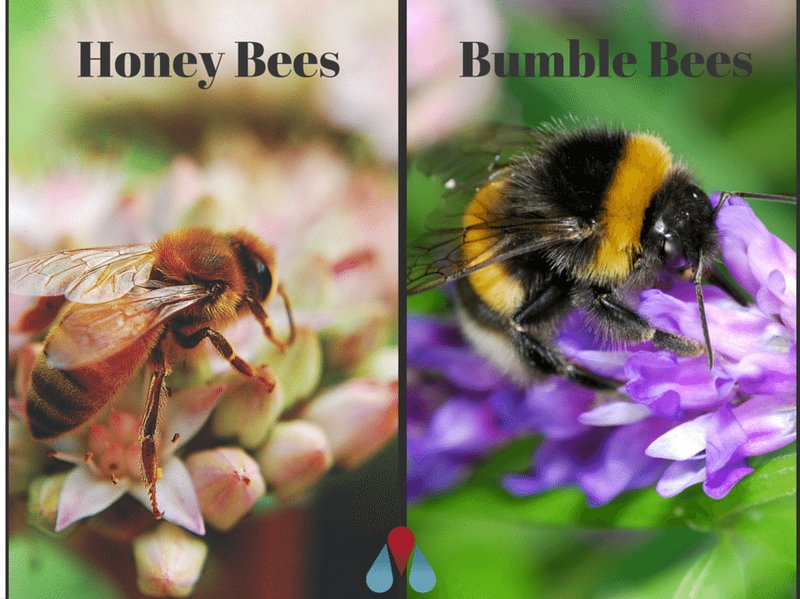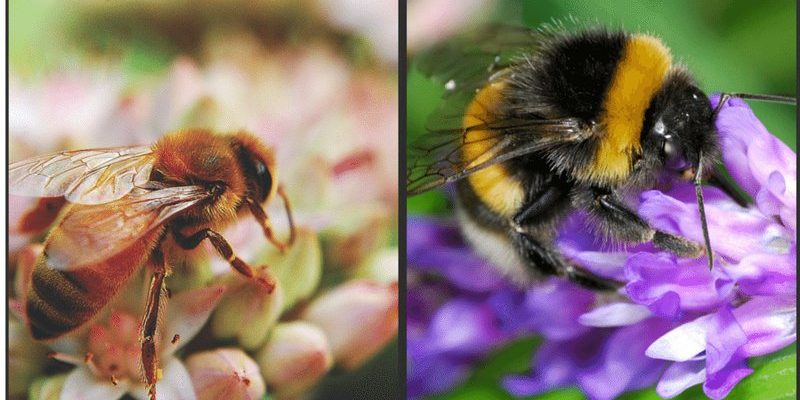
Let’s imagine bees as characters in a bustling city. Each type has its own job and style, contributing to the community in different ways. Bumblebees are like the friendly, fuzzy delivery people—plump and hardworking, they zip from flower to flower, collecting pollen. They’re different from the more solitary or industrious honeybees and the tiny but mighty sweat bees. So, let’s dive into this buzzing world and uncover what makes bumblebees special compared to their bee buddies.
What Are Bumblebees?
Bumblebees belong to the genus *Bombus*, and there are over 250 species of them around the globe. These bees are easily recognized by their large, round bodies and their distinctive black and yellow stripes, which often have a soft, fuzzy appearance. This fuzziness isn’t just for show; it helps them collect pollen more efficiently. Bumblebees thrive in cooler temperatures compared to other bees, which is why you might see them flitting around even on chilly days.
One of the coolest things about bumblebees is their social structure. They live in colonies that can range from 50 to a few hundred individuals, and each colony is headed by a queen. The queen’s job is to lay eggs and keep the colony growing, while the worker bees take care of foraging, nest building, and protecting the hive. This teamwork is essential for their survival, especially in challenging environments.
You might be wondering why bumblebees are so important. Well, they’re excellent pollinators. They help pollinate a variety of plants, including fruits, vegetables, and flowers, which not only supports their colonies but also benefits gardens and agriculture. The next time you see a bumblebee buzzing around, remember it’s like a tiny superhero, keeping our food supply healthy and diverse.
Other Common Bee Types
Now that we’ve covered bumblebees, let’s look at some other common bee types. This will help highlight their differences and similarities. The most recognized among them are honeybees, solitary bees, and carpenter bees. Each type has unique traits and roles in nature.
Honeybees are probably the most famous of all. They live in large colonies, sometimes numbering in the thousands. Their primary role is not just to pollinate but also to produce honey, which they store as food for the colony. Honeybees have a more structured social system, with a queen, workers, and drones, all playing distinct roles. Unlike bumblebees, honeybees are more dependent on warmer climates and are less active in cooler temperatures.
Then we have solitary bees, which include types like leafcutter bees and mason bees. As the name suggests, these bees don’t live in colonies. Instead, they often nest alone and take care of their young individually. Solitary bees are fantastic for pollination but don’t produce honey like honeybees. They can also be found in a variety of habitats, from urban gardens to wildflower meadows.
Carpenter bees might catch your eye too. They’re often mistaken for bumblebees because of their similar appearance, but they have a shiny, hairless abdomen. Unlike bumblebees, carpenter bees prefer to burrow into wood to create nests. They are also solitary, like the other types we mentioned, but their nesting behavior can lead to some issues for homeowners if they choose untreated wood for their homes.
Physical Differences
When you look closely, bumblebees and other bees have distinct physical differences that make identification a bit easier. Bumblebees are robust, with their hefty bodies covered in dense hairs, which are ideal for pollen collection. They also have a more rounded shape, giving them that signature “cuddly” look.
In contrast, honeybees are smaller and more streamlined. They have shorter bodies and a more slender appearance, which suits their bustling lifestyle in hives. Honeybees also have a unique feature: a special structure on their hind legs called a pollen basket, designed for carrying pollen back to their colonies.
Solitary bees vary greatly in size and shape, as there are over 20,000 species of them! Some are tiny and sleek, while others may have fuzzy bodies similar to bumblebees. However, most solitary bees lack the distinct banding of black and yellow stripes that bumblebees are known for. This variety offers a glimpse into the incredible diversity of the bee world.
Lastly, carpenter bees not only look similar to bumblebees but also share some behaviors, like pollination. However, the shiny abdomen of a carpenter bee sets it apart visually. Their nesting habits also distinguish them; whereas bumblebees thrive in pre-existing cavities, carpenter bees create their own nests by boring into wood.
Behavioral Differences
Behavioral patterns are another way to tell bumblebees apart from other bees. Bumblebees are social insects and work collaboratively, but they aren’t as regimented as honeybees. They can forage for food both individually and in small groups, which allows them to explore a variety of flowers and plants.
Honeybees, on the other hand, have a highly organized foraging strategy. They communicate using a fascinating dance known as the “waggle dance” to inform other hive members about the location of food sources. This teamwork is key for their survival and efficiency, especially when collecting nectar to make honey.
Solitary bees don’t typically exhibit any social behaviors since they operate alone. They’re often focused on finding the best nesting sites and food sources for their young rather than collaborating with others. This independence makes them highly adaptable to various environments, but it also means they have less direct impact on community foraging.
When it comes to carpenter bees, they may seem a bit more aggressive compared to bumblebees and honeybees. While their sting is painful, they usually don’t sting unless threatened. Their behavior of boring into wood can also lead to conflicts with humans, especially if they target structures and furniture.
Pollination Techniques
Bumblebees are exceptional pollinators, utilizing a unique technique called “buzz pollination.” Essentially, they vibrate their bodies rapidly to dislodge pollen from flowers. This method works wonders for plants like tomatoes and blueberries, making bumblebees a crucial component in the growth of these crops.
Honeybees also play a significant role in pollination, but they do so through a method known as “nectar collection.” They gather nectar and pollen while visiting flowers, but they don’t have the same buzzing technique as bumblebees. Honeybees are efficient and can visit large numbers of flowers quickly, making them an essential part of commercial agriculture.
Solitary bees are effective pollinators as well, often focusing on fewer flowers but providing important services to the plants they do visit. They tend to have personal preferences for specific types of flowers and can be highly specialized in their pollination efforts.
Carpenter bees contribute to pollination similarly to bumblebees, as they also have the ability to buzz pollinate. However, they tend to focus on larger flowers, which can limit their effectiveness compared to the more versatile bumblebee.
Conservation and Importance
Conserving bumblebees and other bee types is essential for maintaining healthy ecosystems. With the decline of bee populations globally, it’s crucial to recognize the vital roles these insects play in food production and biodiversity. Bumblebees, with their unique pollination abilities, are particularly important due to their ability to thrive in cooler temperatures and pollinate plants that other bees might struggle with.
Supporting bumblebee populations can involve simple actions at home, too. Planting a variety of nectar-rich flowers and reducing pesticide use can create a welcoming environment for these fuzzy pollinators. Consider creating a bee-friendly garden with native plants that bloom at different times throughout the year. This not only supports bumblebees but also benefits honeybees, solitary bees, and other pollinators.
Moreover, understanding the differences between bee types helps us appreciate their diverse contributions. For example, while honeybees are crucial for agricultural crops, bumblebees aid in the pollination of wildflowers in natural habitats. Just imagine the impact of losing bumblebees—many of our favorite fruits and vegetables might be at risk!
In conclusion, every bee type brings something special to our world. By learning the difference between bumblebees and other bees, we can advocate for their protection and appreciate their hard work. So, the next time you spot a bumblebee buzzing nearby, take a moment to watch it at work—it’s a little miracle of nature contributing to our planet’s health!

